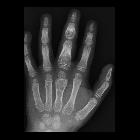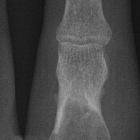enchondromatosis









Enchondromatosis, also known as Ollier disease (see Terminology section), is a non-hereditary, sporadic, skeletal disorder characterized by multiple enchondromas principally located in the metaphyseal regions.
Terminology
Some authors make a distinction between Ollier disease and enchondromatosis on the basis of distribution. In the original description of Ollier disease, the enchondromas were predominantly confined to one side and limited to the limbs. As such, some authors prefer to use the term Ollier disease in cases where this distribution is present and use enchondromatosis or multiple enchondromatosis for cases where the distribution is more symmetric .
Epidemiology
Ollier disease is seen in both sexes without gender predilection and usually becomes apparent by early childhood . The condition is non-hereditary and is thought to occur as a result of random and spontaneous mutations.
Clinical presentation
Clinical presentation is usually with deformity and pain (present only during periods of rapid growth) . If pain occurs when the child is older, this should raise the concern of malignant transformation or pathological fracture. If involvement of the lower limbs is significant, leg length discrepancy may occur.
Pathology
In distinction from solitary lesions, enchondromas of enchondromatosis are more likely to be hypercellular in nature, yet are still considered benign in the absence of other aggressive findings .
The etiology of enchondromatosis has been associated with post-zygote state mutations during development. More interestingly, it has been reported that the PTHrP (parathyroid hormone-related protein) receptor has been implicated as a gene responsible for cases of enchondromatosis in patients with a family history of mild skeletal dysplasia in their male parents.
Once the individual stops growing then in general, so do the enchondromas. If growth occurs then, this raises the possibility of malignant transformation .
Associations
There is an increased risk of chondrosarcoma occurring later in life. The risk has been reported to be up to 25-30% at 40 years . Additionally, there is an increased risk of developing gliomas, pancreatic and juvenile granulosa cell tumors of the ovary .
Occasionally patients will also be afflicted with multiple osteochondromas. This rare combination is known as metachondromatosis.
An association with primary CNS tumors has also been reported .
Location
They can occur anywhere but most frequently involve the short tubular bones of the hands and feet. Most patients have bilateral involvement but often significant asymmetry .
Radiographic features
Radiographs show multiple enchondromas. Larger lesions can show cartilage calcification in a typical rings and arcs pattern.
Vertical streaks of lucency also present in the metaphysis of long bones, extending to the epiphysis, which represents columns of cartilage.
For further discussion of appearances, please refer to the article on enchondromas.
Treatment and prognosis
The extent of disease is highly variable and thus so is the degree of impairment. If only a few bones are involved, then little if any handicap is present, although the affected bones do have a higher rate of fracture.
If there is extensive involvement, it might cause growth impairment, deformity (such as leg length discrepancy or Madelung deformity of the forearm), and functional impairment and these may require corrective surgery.
History and etymology
It is named after Louis Xavier Édouard Léopold Ollier (1830-1900), a French orthopedic surgeon .
Differential diagnosis
Imaging differential considerations include:
- Maffucci syndrome: presence of soft-tissue hemangiomas, heralded on plain films by phleboliths
- metachondromatosis: osteochondromas also present
- sarcoidosis: lace-like phalanges
Siehe auch:
- Sarkoidose
- Enchondrom
- Chondrosarkom
- kartilaginäre Exostose
- Fingertumoren
- Beckwith-Wiedemann-Syndrom
- Enchondrom Mittelhandknochen
- Maffucci-Syndrom
- Metachondromatose
- Enchondrom Phalangen
und weiter:
- Enchondrom Femur
- Fibröse Dysplasie
- Chondrom
- Enchondrom Humerus
- Auftreibung Metaphysen
- Osteopathia striata
- Proteus-Syndrom
- Enchondroma protuberans
- Knochentumoren
- Madelung-Deformität
- premature closure of a growth plate
- zystische Angiomatose
- Erlenmeyer flask deformity of the femur
- Chondromatose
- multiple benign lucent bone lesions (mnemonic)
- Enchondrom distales Femur
- verkalktes Enchondrom
- multiple T2 hyperintense ossäre Läsionen
- Zyste Mittelhandknochen

 Assoziationen und Differentialdiagnosen zu Ollier-Syndrom:
Assoziationen und Differentialdiagnosen zu Ollier-Syndrom:









